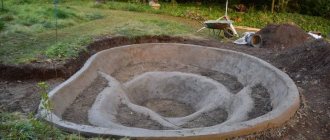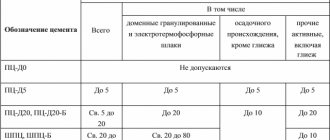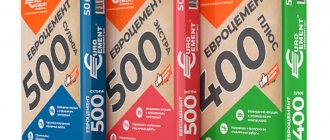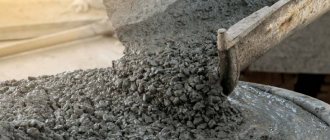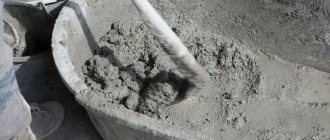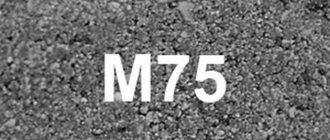Cement-sand mixtures (CSM) are a popular building material at any construction site. The main reason for its popularity is the readiness of the DSP for use.
In accordance with their name, CPS consists of cement, sifted purified sand and various additives - “pour into a concrete mixer, mix with water and in a few minutes the cement mortar is ready for use.” There is no need to purchase sand, cement and plasticizers separately and waste energy and time mixing them.
Production of cement-sand mixture (CSM) grade M400 class B30
A dry mixture of sand and cement M400 is a good alternative to concrete, as it has high strength and is supplied in bags or big bags, which is convenient in cramped conditions.
DSP can be stored indoors for up to 6 months. It is characterized by strength, frost and moisture resistance, and plasticity. During operation, the finished layer does not crack and resists the effects of sulfates well. Sand concrete mixed manually at a construction site may not have the specified characteristics due to errors in the selection of the composition. The DSP produced at the plant is guaranteed to comply with the declared parameters, and also has a high coefficient of resistance to shrinkage deformations.
You can buy M400 sand concrete directly from RBU through the website using special certification selection selectors. Orders are accepted around the clock. If you have questions about the features of the M400 CPS or the technical characteristics of the material, ask them to the concrete plant managers by contacting them by phone.
Production of ready-made cement mixtures and solutions with delivery from 1 m³
Area of use
The fact that sand concrete M400 belongs to heavy concrete allows it to be used for the formation of critical and heavily loaded structural elements in special engineering structures.
The main area of application of the solution is the installation of high-strength, wear-resistant floors in factory and production workshops, garages and warehouses. Also used as a load-bearing layer in basements and workshops.
It is noteworthy that the composition of sand concrete M400 in mass fractions of cement and sand is so correctly balanced that it has minimal subsidence. In this regard, the required amount of dry mixture is very easy to calculate. The dry volume of the mixture practically coincides with the finished volume of the solution.
Sand concrete M400 Willis is widely used for pouring foundations of monolithic structures. This solution not only perfectly withstands the load of walls and roofs, but also perfectly withstands floor slabs, load-bearing columns and beams.
There are also various options for sand concrete blocks, which are made using vibrocompression. In order for sand concrete slabs to gain good density and strength, they are additionally compacted under high pressure.
Sand concrete 400 has a wide range of applications in installation work.
Where is the cement-sand mixture M400 used?
A mixture of sand and cement is suitable for interior, exterior and facade work. It is used in the construction of residential, public and industrial facilities. The following work can be carried out using sand concrete M400:
- screeding and pouring of floors for basements, workshops, garages, workshops and intensively used premises;
- production of basement or structural screed;
- creation of small architectural forms, reclamation structures;
- foundation construction;
- sealing cracks, seams, joints;
- masonry walls.
It is recommended to use sand concrete at base temperatures in the range from +5 to +30 degrees. To carry out work in the cold season, indicate in the order form the need to include antifreeze additives.
Old and new markings of M400 cement
When supplying packaged M400 cement, the material can be marked in one of two ways:
- According to the USSR standard of 1985, where the number 400 after the letter M expresses the compressive strength of hardened cement (in kg per cm2) after 28 days of curing;
- According to the updated Russian standard 31108-2003, where the above strength indicator is expressed in megapascals (MPa) and for M400 grade material it is 32.5.
The labeling of cement products also necessarily reflects the presence of plasticizers and modifying additives in them. The introduction of the latter into the source material makes it possible to improve the solution’s resistance to corrosion, increase its moisture resistance, accelerate/slow down hardening, make it immune to extremely low temperatures, etc. Some additives are of a purely technological nature, helping to grind Portland cement clinker or facilitating long-term trouble-free transportation of the dry mixture.
So, in the old and new systems, the designations of the same material without additives will look like this: M400 D0 and CEM I 32.5B. Moreover, the presence and percentage of additives in the old marking is reflected by a number after the letter D (from 0 to 20), and in the new one - by a Roman symbol before the strength value (I or II). The letter index in the designation of the material according to GOST of 2003 shows the rate of hardening of a particular Portland cement: B - fast-hardening, N - normal-hardening.
Technical characteristics of sand concrete
The mixture contains coarse purified sand and Portland cement M400-M500 without foreign impurities. To impart specific technical characteristics, plasticizers, frost-resistant and hydrophobic additives are added to the DSP.
Sand concrete M400 has the following parameters:
- compressive strength - 400 kgf/sq. cm (40 MPa);
- adhesion strength at separation - 0.3 MPa;
- frost resistance - F200;
- viability of the finished solution is 2 hours.
In order to maintain technical characteristics, when mixing sand concrete, it is important to use purified water without chemical and organic impurities. If this is not possible, order a ready-made solution from RBU. Construction materials will be delivered to the site using our own mixers with a capacity of 7-12 cubic meters. m.
Preparing sand concrete for work
Purchased dry sand concrete mixture is an almost ready-to-use product. Which is a convenient option for use on private construction sites. You just need to add water to the dry mixture and stir until smooth.
Please note that preparing a solution of M400 sand concrete on your own will cost much less than purchasing a ready-made factory analogue.
To prepare the working solution, you just need to calculate the required amount of bagged dry material. For example, a package of sand concrete M400 50 kg will require about 6 liters of clean water. The amount of water required to mix the ideal solution is indicated in the instructions included with each package of sand concrete.
Basically, the amount of water is taken at the rate of 1.35 -1.6 liters per 10 kg of dry sand concrete mixture. Although, the proportional amount of ingredients may vary depending on the mechanical needs of the solution.
Technique for preparing the solution: pour clean water over the dry mixture and stir until the material is completely homogeneous. It is advisable to carry out the process of mixing ingredients mechanically using a concrete mixer or mixing attachment. The solution is a dense and heavy material, so it is unlikely that it will be possible to achieve good uniformity by hand.
After the first mixing approach, the solution needs to stand for about 10-20 minutes, then mix thoroughly again.
It is recommended to use the finished sand concrete solution within 2 hours after mixing.
Price of sand concrete M400 per 1 m³ or ton
The cost of the finished mixture of sand and cement is determined based on the components included in the composition. Exact prices can be found from managers or in RBU price lists. Transportation costs are calculated separately when placing an order.
A concrete plant in Moscow ships M400 sand concrete directly, bypassing intermediaries and resellers. This, as well as wholesale purchases of raw materials from mining sites, guarantee a low price for the finished mixture.
About Us:
- Concrete plant in Moscow;
- Sale from the factory at the lowest price;
- GOST
quality confirmed by certificates; - Accredited laboratory;
- Free laboratory testing of our CPS on days 7 and 28 with the issuance of a protocol for registration of KS-2, KS-3;
- Automated underfill protection system;
- Quality certificate for each issue;
- Own fleet of concrete mixers and concrete pumps;
- Free visit to the site for measurements, organization of access routes, consultation, as well as a second free visit to accompany the shipment;
- An integrated approach to the organization of construction: provision of access roads, excavation work, installation of formwork, delivery and supply of concrete with concrete pumps, monolithic work, rental of equipment, special equipment;
- Delivery from 1 m³;
- Own sales service;
- High level of customer support – personal manager (personal responsibility);
- We work 24/7.
Composition and proportions
Any ready-made mixture is produced in accordance with GOST standards; only in the laboratory can the required physical properties of the final material be achieved. To obtain a mixture with regulated characteristics, the following components will be required:
- Portland cement M500.
- The sand used is fractional with a grain size of up to 2 mm. The material is pre-washed from dust, because it violates the strength of the composition.
- Water is required to be purified from impurities and salts. The presence of metal salts will lead to rapid erosion.
Proportions for preparing 1m³ of CPS M400 B30 at a concrete plant in Moscow
- Portland cement M500: 490 kg;
- Sand: 1210 kg;
What does it consist of?
Sand concrete 400 is a composite multicomponent material. The composition of the classic dry mixture consists of three main components.
- Portland cement M400 is the basic component of the dry mixture;
- Clean, granular sand with a fraction diameter of up to 3 mm, as well as river sand;
- Additional fillers, such as: granite chips, plasticizers and quality improvers;
If you look at the surface, sand concrete 400 in terms of the composition of its components is very similar to ordinary concrete mass. But this similarity is superficial. Obvious differences can be noticed after the first use of the material.
Delivery of DSP M400 from 1 cubic meter. m
Applications are accepted 24/7 and processed promptly. Delivery of sand concrete in big bags can be carried out on the same day of request. The mixture is shipped from RBU in Moscow, which is part of the general network of concrete plants. The BSU is located close to transport interchanges, which guarantees prompt delivery throughout Moscow and the region. Delivery price from 300 rubles per cubic meter.
Order ready-made mixture M150 by phone: +7 (495) 128-83-80 or via the feedback form. Our manager will answer any questions and give advice on preparing any building composition.
Material consumption
To calculate the consumption of sand concrete, first of all, you need to determine the average thickness of the pour. We carry out simple arithmetic operations: the instructions for the package of sand concrete indicate that the consumption of sand concrete per 1 m? with a poured layer thickness of 1 cm it is 18-20 kg.
Please note that construction experts recommend, even with accurate calculations, to take dry sand concrete mixtures with a reserve of approximately 10% more than the required amount.
Sand concrete mixture, being an ergonomic and waterproof material, has minimal consumption when used.


